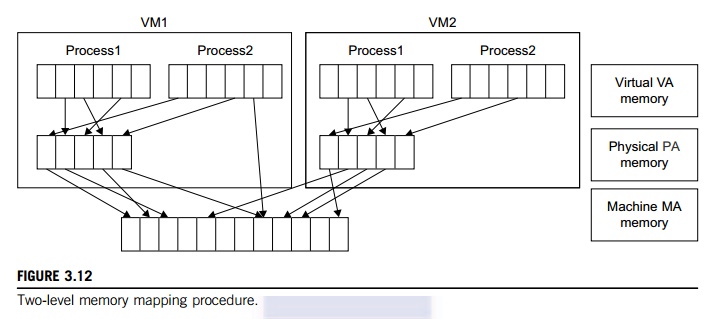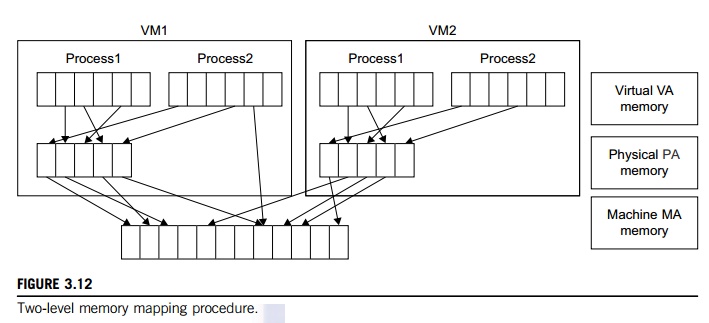Chapter: Distributed and Cloud Computing: From Parallel Processing to the Internet of Things : Virtual Machines and Virtualization of Clusters and Data Centers
Memory Virtualization
Memory Virtualization
Virtual memory virtualization is similar to the virtual memory support provided by modern operating systems. In a traditional execution environment, the operating system maintains mappings of virtual memory to machine memory using page tables, which is a one-stage mapping from virtual memory to machine memory. All modern x86 CPUs include a memory management unit (MMU) and a translation lookaside buffer (TLB) to optimize virtual memory performance. However, in a virtual execution environment, virtual memory virtualization involves sharing the physical system memory in RAM and dynamically allocating it to the physical memory of the VMs.
That means a two-stage mapping process should be maintained by the guest OS and the VMM, respectively: virtual memory to physical memory and physical memory to machine memory. Furthermore, MMU virtualization should be supported, which is transparent to the guest OS. The guest OS continues to control the mapping of virtual addresses to the physical memory addresses of VMs. But the guest OS cannot directly access the actual machine memory. The VMM is responsible for mapping the guest physical memory to the actual machine memory. Figure 3.12 shows the two-level memory mapping procedure.

Since each page table of the guest OSes has a separate page table in the VMM corresponding to it, the VMM page table is called the shadow page table. Nested page tables add another layer of indirection to virtual memory. The MMU already handles virtual-to-physical translations as defined by the OS. Then the physical memory addresses are translated to machine addresses using another set of page tables defined by the hypervisor. Since modern operating systems maintain a set of page tables for every process, the shadow page tables will get flooded. Consequently, the perfor-mance overhead and cost of memory will be very high.
VMware uses shadow page tables to perform virtual-memory-to-machine-memory address translation. Processors use TLB hardware to map the virtual memory directly to the machine memory to avoid the two levels of translation on every access. When the guest OS changes the virtual memory to a physical memory mapping, the VMM updates the shadow page tables to enable a direct lookup. The AMD Barcelona processor has featured hardware-assisted memory virtualization since 2007. It provides hardware assistance to the two-stage address translation in a virtual execution environment by using a technology called nested paging.
Example 3.6 Extended Page Table by Intel for Memory Virtualization
Since the efficiency of the software shadow page table technique was too low, Intel developed a hardware-based EPT technique to improve it, as illustrated in Figure 3.13. In addition, Intel offers a Virtual Processor ID (VPID) to improve use of the TLB. Therefore, the performance of memory virtualization is greatly improved. In Figure 3.13, the page tables of the guest OS and EPT are all four-level.
When a virtual address needs to be translated, the CPU will first look for the L4 page table pointed to by Guest CR3. Since the address in Guest CR3 is a physical address in the guest OS, the CPU needs to convert the Guest CR3 GPA to the host physical address (HPA) using EPT. In this procedure, the CPU will check the EPT TLB to see if the translation is there. If there is no required translation in the EPT TLB, the CPU will look for it in the EPT. If the CPU cannot find the translation in the EPT, an EPT violation exception will be raised.
When the GPA of the L4 page table is obtained, the CPU will calculate the GPA of the L3 page table by using the GVA and the content of the L4 page table. If the entry corresponding to the GVA in the L4

page table is a page fault, the CPU will generate a page fault interrupt and will let the guest OS kernel handle the interrupt. When the PGA of the L3 page table is obtained, the CPU will look for the EPT to get the HPA of the L3 page table, as described earlier. To get the HPA corresponding to a GVA, the CPU needs to look for the EPT five times, and each time, the memory needs to be accessed four times. There-fore, there are 20 memory accesses in the worst case, which is still very slow. To overcome this short-coming, Intel increased the size of the EPT TLB to decrease the number of memory accesses.
Related Topics